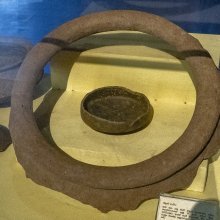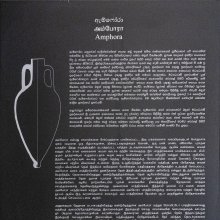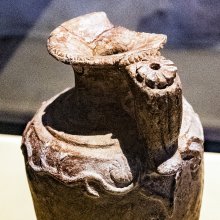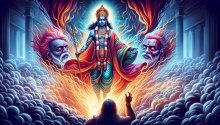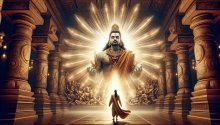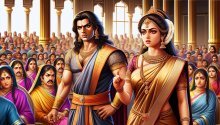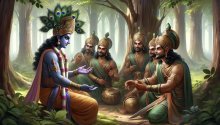Welcome to Wisdom Library
Welcome to Wisdom Library. This is a place of knowledge and wisdom, but not of silence. Here you can find a large and ever expanding collection of Books, Articles, Essay's, Hymns and much more. I will do my best to suit everyone with the best tools needed for extensive research on subjects such as Buddhism, Hinduism, Jainism, Ancient History, Philosophy, etc...
Latest Text Added:
Latest Images Added:
Latest Mahabharata Summaries:
Recently updated Definitions:
- Miccam 26 Apr.
- Cocci 26 Apr.
- Nuniyati 26 Apr.
- Suranga 26 Apr.
- Kummiruttu 26 Apr.
- Purankaval 26 Apr.
- Ghachchapacch 26 Apr.
- Languti 26 Apr.
- Talai-ceytukol 26 Apr.
- Sunghinu 26 Apr.
- Totimakal 26 Apr.
- Papanashini 26 Apr.
- Play 26 Apr.
- Urucipar 26 Apr.
- Thepchinu 26 Apr.
- Atarppatu 26 Apr.
- Vellimani 26 Apr.
- Vishvaksenar 26 Apr.
- Bhayo 26 Apr.
- Kukaiccatti 26 Apr.
- Jhopadi 26 Apr.
- Tanikaippuranam 26 Apr.
- Gunavana 26 Apr.
- Santan 26 Apr.
- Paccutampu 26 Apr.
- Bacchibacchi 26 Apr.
- Gahiऱ्yaunu 26 Apr.
- Venmukil 26 Apr.
- Svargaloka 26 Apr.
- Vilanghana 26 Apr.
- Inegine 26 Apr.
- Katalipakam 26 Apr.
- Peccarravan 26 Apr.
- Trinabhumi 26 Apr.
- Kum 26 Apr.
- Atirktchaap 26 Apr.
- Tantuppurru 26 Apr.
- Hama-phalai 26 Apr.
- Pancayakam 26 Apr.
- Vyavahita 26 Apr.
- Avyavahita 26 Apr.
- Samkalpa 26 Apr.
- Pramanartha 26 Apr.
- Pramanarthanirupana 26 Apr.
- Jhumma 26 Apr.
- Kaittu 26 Apr.
- Shabdatmakapramana 26 Apr.
- Visheshasvarupa 26 Apr.
- Shabdatmakapramanavyuhavisheshasvarupa 26 Apr.
- Satyavada 26 Apr.
- Shabdatmakapramanavyuhavisheshasvarupanirupana 26 Apr.
- Shabdatmakapramanavyuha 26 Apr.
- Shabdatmakapramanavyuhanirupana 26 Apr.
- Hvanga 26 Apr.
- Pheco 26 Apr.
- Harhar 26 Apr.
- Vyashti 26 Apr.
- Vyashtisthiti 26 Apr.
- Vyavahara 26 Apr.
- Tirodhana 26 Apr.
- Anugraha 26 Apr.
- Tirobhava 26 Apr.
- Mahaprana 26 Apr.
- Mahasrishti 26 Apr.
- Mahasthiti 26 Apr.
- Mahapralaya 26 Apr.
- Neri 26 Apr.
- Bhasmeekaran 26 Apr.
- Sthiti 26 Apr.
- Nirvalukkai 26 Apr.
- Dimga 26 Apr.
- Pancakritya 26 Apr.
- Krityapancaka 26 Apr.
- Muthyai 26 Apr.
- Utanpatuttu 26 Apr.
- Utro 26 Apr.
- Vyavasthapaneey 26 Apr.
- Samnigudha 26 Apr.
- Sarvarahasya 26 Apr.
- Rahasyashastra 26 Apr.
Recently updated Articles:
- Section XLIV 26 Apr
- Section XLIII 26 Apr
- Section XLII 26 Apr
- Section XLI 26 Apr
- Section XL 26 Apr
- Section XXXIX 26 Apr
- Section XXXVIII 26 Apr
- Section XXXVII 26 Apr
- Section XXXVI 26 Apr
- Section XXXV 26 Apr
- Section XXXIV 26 Apr
- Section XXXIII 26 Apr
- Section XXXII 26 Apr
- Section XXXI 26 Apr
- Section XXX 26 Apr
Latest Site News:
I have released an online tool for the ancient Indian language spoken in Kerala, called Malayalam. You can convert between the Malayalam script and their Unicode representation in Latin characters,…
As the title suggest, this new script is used for typing Ancient Greek characters. This is done by using a program called AutoHotkey. You will have to install the proper version for your system fir…
The following script let's you type characters such as ȧ ā ṣ ś ṭ easily by using a program called AutoHotkey. You will have to install the proper version for your system first. After you installed …

